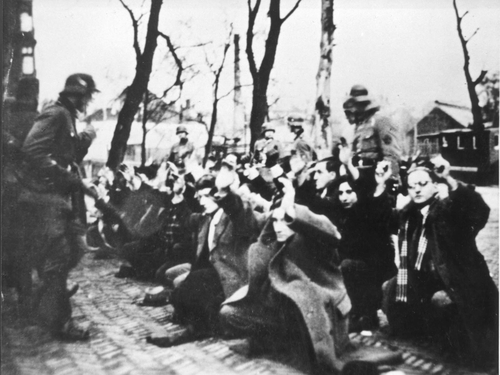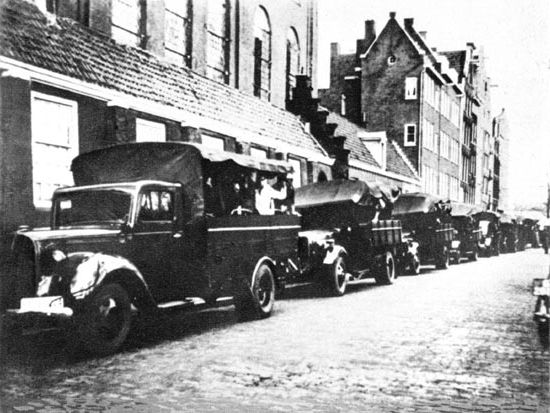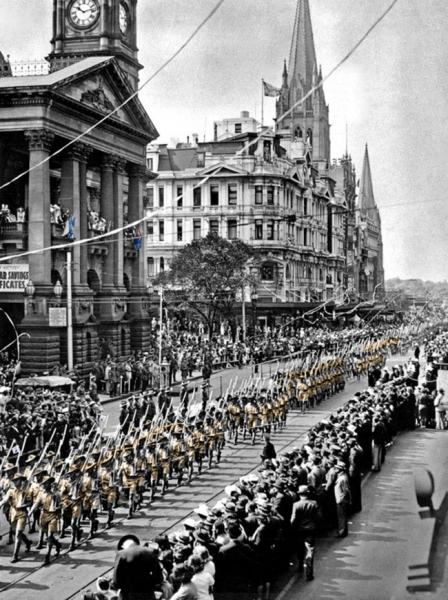Saturday 22 February 1941
 |
| Jews rounded up in Amsterdam, 22 February 1941. |
East African Campaign: The 12th African Division and Gold Coast Brigade attack Jelib frontally while another force, 1/1 King's African Rifles, comes in from the rear. The 22nd East African Brigade cuts the road to Mogadishu, blocking the Italians from retreating. The action begins at 05:45, and the Italian Colonial Infantry rapidly gives way. The British advance in armored cars and brush aside all resistance. By 13:00, the 12th African Division takes Jelib, which effectively ends Italian resistance on the key Juba River line. Firefights continue in the area throughout the afternoon, but the Italians are sent into full retreat. They try to establish another line between the river and Mogadishu, but the Italian command had staked everything on defending the river and have nothing in reserve. Some 30,000 Italian troops (mostly native) are either killed, captured or fleeing in wild terror.
Royal Navy cruiser HMS Shropshire sits offshore and bombards Brava. General Cunningham cables Middle East Commander General Archibald Wavell in Cairo, telling him that his forces can continue operations toward Harar, some 800 miles beyond Mogadishu.
British troops take Cub Cub from the 112th Colonial Battalion.
 |
| "William Wyckoff, of the American-Scandinavian Field Hospital in Norway, x-rays a British boy in his bed at the American Hospital in Britain in February 1941. Wyckoff had previously been stationed at Namsos in Norway." This is the Park Prewett Hospital in Basingstoke, Hampshire. © IWM (D 2068). |
The Luftwaffe switches targets after dark. It sends 17 bombers against the port of Hull. There are many deaths, and extensive damage is caused by aerial mines.
Australian Prime Minister Robert Menzies, visiting London, provides a fresh and objective perspective on the effects of the Blitz in his diary. He notes that:
Once you get past St. Paul's, you come on whole blocks of which only an occasional twisted girder or brick wall remains.This also is what contemporary photos show. However, the British press for one reason or another is minimizing the extent of the devastation by using such tricks as cropping photos to show St. Paul's and not the devastation around it.
RAF No. 317 "Wilno" (Polish) Fighter Squadron forms at RAF Acklington.
 |
| "Onboard a convoy vessel on patrol. Firing the starboard depth charge throwers." 22 February 1941. © IWM (HU 110317). |
Today, his luck changes. At about 10:55, the lookouts spot a convoy heading west. This means that the ships are empty... but they are still worthy targets. Best of all, they appear to have no escorts at all. The two cruisers move in for the kill, but the ships disperse as soon as they see the German warships. During the entire engagement, they sink the following:
- British tanker Lustrous (6156 tons)
- British freighter Kantara (3237 tons)
- British freighter Trelawny (4689 tons, one death)
- British freighter A. D. Huff (5866 tons, ten deaths)
- British freighter Harlesden (5483 tons, seven deaths)
Then, an event full of portent happens. Lütjens, of his own initiative, decides to send a radio report to Berlin detailing his force's success against the convoy. This, of course, ensures that his force's success will make the next day's propaganda broadcasts, which is highly prized in the Wehrmacht. Anyone familiar with the voyage of battleship Bismarck will recognize instantly that this unnecessary message-sending is a Lütjens trademark. It does not cost him anything... this time.
Lütjens now decides to move on, knowing that the surviving members of the convoy would have signaled the Royal Navy about his position. He signals tankers Schlettstadt and Esso Hamburg to meet him far to the south, near the Azores. The German ships steam on, unmolested and victorious.
U-96 (Heinrich Lehmann-Willenbrock) is lurking around the shipping lanes northwest of Ireland on its third patrol when it spots an abandoned tanker west of the Hebrides. It is 6999-ton British tanker Scottish Standard, which the Luftwaffe bombed on the 21st. The crew has abandoned ship, but there is a destroyer, HMS Montgomery, standing guard. Lehmann-Willenbrock quickly puts two torpedoes into the tanker, finally sinking it, then dives to avoid the inevitable escort attack. The Montgomery spends five hours and drops 37 depth charges, but U-96 gets away. There are five deaths.
Royal Navy destroyer HMS Montgomery, which rescued the survivors of the Scottish Standard, spots a submarine - but it isn't U-96. Instead, it is the Italian submarine Marcello. The Montgomery attacks and sinks the Marcello with all hands. One of the rebadged US destroyers sent to the Royal Navy in the destroyers-for-bases deal, the Montgomery is proving its worth.
U-108 (K.Kapt. Klaus Scholtz), on its first patrol out of Wilhelmshaven, is operating south of Iceland when it spots 1617-ton Dutch freighter Texelstroom. Scholtz makes short work of the freighter for U-108's first victory.
British 6554-ton tanker Luxor is damaged during the final night of the Luftwaffe bombing of Swansea on 21/22 February.
The Luftwaffe also damages 7628-ton British freighter Kingston Hill far out in the Northwest Approaches. The ship manages to make it to Loch Ewe in tow.
In the same attack as on the Kingston Hill, the Luftwaffe damages 3621-ton British freighter Keila. The ship manages to make it to the Clyde without assistance.
Royal Navy destroyer HMS Icarus lays minefield JK in the English Channel.
Kriegsmarine minelayers Brummer, Cobra, and Konigin Luise lay minefield Swine east of the Shetlands.
Royal Navy submarine HMS Union (N 56, Lt. Robert M. Galloway) is commissioned, as is antisubmarine warfare trawler HMS Mazurka (T 30, Lt. Victor R. Tyrrell).
U-81 is launched, U-257 is laid down.
 |
| Rounding up Jews in Amsterdam, on or about 22 February 1941. |
At Tobruk, the confusion continues in the port. Several ships have hit mines in the harbor, which supposedly has been swept clean. Today, Royal Navy anti-submarine whaler Southern Seas collides with a lighter and suffers damage.
On or about this date, HMS Upright torpedoes and sinks 2365 ton Italian freighter Silvia Tripcovich off Kuriat Island.
Royal Navy submarine HMS Regent fires at Italian shipping off Tripoli but misses.
The Free French continue shelling the Italian El Tag fortress at Kufra. The fort is well-garrisoned, but the Italians have no defense to the French 75mm field gun or mortars that are firing at them. The inexperienced Italian commander of the fort also is unwilling to make a sortie out to confront the French directly, despite the fact that he outnumbers them.
The Luftwaffe mines the Suez Canal again. Previous minings have been extremely successful at disrupting traffic through the canal.
General Rommel is determined to take the initiative on land with his fledgling Afrika Korps despite the fact that all of his troops have not yet landed. He sends troops to forward positions near El Agheila to conduct probing attacks.
 |
| Trucks used to transport hostages to a police camp outside Amsterdam, 22/23 February 1941. |
US/Chinese Relations: Ernest Hemingway and wife Martha Gellhorn are in Hong Kong on an unofficial mission to gather data on the war situation.
 |
| German troops assemble hostages in the Jonas Daniel Meijer Square in Amsterdam, 22/23 February 1941. |
Churchill, in a memo to Secretary of State for War David Margesson, fixes the projected size of the British army at 53 divisions, 11 of them armored. By comparison, the Wehrmacht at its peak has about 300 divisions, the US Army 90 divisions and the Soviet Union over 600, though the divisions of each army differ greatly in size and equipment (a full-strength Wehrmacht Division, for instance, is generally comparable to a Soviet Corps). Of course, it is still reasonably early in the war, and the British army could be expanded beyond that figure by taking more men from the British industry. Churchill proposes to take a "wait-and-see" attitude about transferring more men to the army.
In another example of his repeated attempts to control the media, Churchill sends a memo to Minister of Information Alfred Duff Cooper about Sir Robert Vansittart. Churchill is upset about broadcasts that Vansittart has been making which "do not represent the policy either of HMG [His Majesty's Government] or the USA." He commands Duff Cooper to end the broadcasts.
Soviet Military: General Dmitry Pavlov, the big loser of the war games held in January, is promoted to the new rank of General of the Army. This is the second-highest rung on the ladder, under Marshal of the Soviet Union. He is the commander of the key Western (Belorussian) Special Military District which defends Moscow.
Filipp Golikov, boss of the Soviet Main Intelligence Directorate (GRU), receives the Order of Lenin from Mikhail Kalinin. This is the Soviet Union's highest decoration, and it is Golikov's first of four - which actually is not very unusual. The record-holder is Defense Minister Dmitriy Ustinov, who received the award 11 times, and ten men received it at least 8 times. The principal characteristic of recipients is not necessarily quality of service, but rather their degree of fervor for the regime.
Bulgaria: Opinion within the country remains deeply unsettled about helping the Germans. When German troops begin openly crossing into the country during the day (as opposed to military officers in mufti which has been the case for months), citizens in several cities protest.
Australia: It is Greece Day, and massive celebrations are held in Melbourne and other cities to honor the Greek war effort.
Indochina: Negotiations continue in Tokyo for a final resolution of the Thai/Vichy French border war in Indochina. The Vichy government resists settling on the proposed terms, which basically call for it to accept all Thai demands and cede the territory originally sought. However, the Japanese - who are seen as holding the balance of power in the region - have their thumb on the Thai side of the scale.
Holocaust: Deaths from starvation in the frigid weather are skyrocketing, but the couldn't care less. They cut the daily bread ration to three ounces, which is less than soldiers at Stalingrad will have to endure through most of the siege
February 1941
February 1, 1941: US Military Reorganization
February 2, 1941: Wehrmacht Supermen
February 3, 1941: World Will Hold Its Breath
February 4, 1941: USO Forms
February 5, 1941: Hitler Thanks Irish Woman
February 6, 1941: Operation Sunflower
February 7, 1941: Fox Killed in the Open
February 8, 1941: Lend Lease Passes House
February 9, 1941: Give Us The Tools
February 10, 1941: Operation Colossus
February 11, 1941: Afrika Korps
February 12, 1941: Rommel in Africa
February 13, 1941: Operation Composition
February 14, 1941: Nomura in Washington
February 15, 1941: Churchill's Warning
February 16, 1941: Operation Adolphus
February 17, 1941: Invade Ireland?
February 18, 1941: Panzerwaffe Upgrade
February 19, 1941: Three Nights Blitz
February 20, 1941: Prien's Farewell
February 21, 1941: Swansea Blitz Ends
February 22, 1941: Amsterdam Pogrom
February 23, 1941: OB-288 Convoy Destruction
February 24, 1941: Okuda Spies
February 25, 1941: Mogadishu Taken
February 26, 1941: OB-290 Convoy Destruction
February 27, 1941: Operation Abstention
February 28, 1941: Ariets Warns Stalin
2020


No comments:
Post a Comment